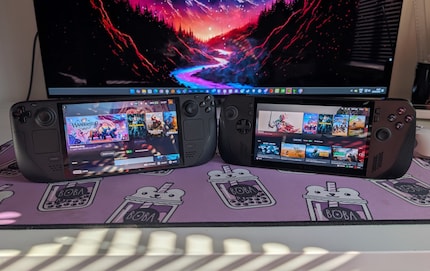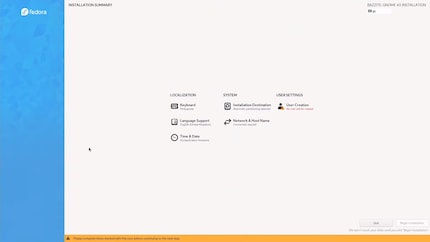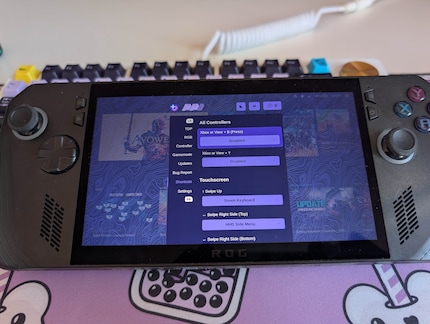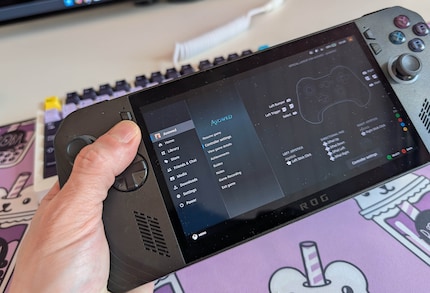
Background information
Switching to Linux: not even that hard
by Kevin Hofer

With Bazzite, SteamOS now also runs on Windows handhelds such as the Asus Rog Ally X. It’s the best of both worlds with virtually no downsides.
The verdict on Windows handhelds is always the same: good hardware, bad software. Although Microsoft’s operating system offers the most freedom, it just doesn’t work with handhelds. Valve knew this too, creating its own Linux software for the Steam Deck in the form of SteamOS. And now there’s Bazzite, a new operating system for Windows handhelds such as Asus’ ROG Ally X.

Bazzite is a slightly modified version of SteamOS available via an installer for various handhelds (or desktops and laptops). It’s for people like me who can’t wait for Valve to make SteamOS officially available for other devices. Only the Lenovo Legion GO S currently enjoys this privilege.
Installation is surprisingly straightforward. All you need is a bootable USB stick with the right version for your handheld. Then just boot from the stick, install Bazzite and the fun can begin.

The whole thing also works in parallel with Windows. For a dual-boot version, I replaced the SSD in my ROG Ally X with a larger one so I’d have enough space for all my games. Replacing the SSD and reinstalling Windows is child’s play thanks to Cloud Recovery from the Asus bios. You can also split the existing partition.
After installing Bazzite, SteamOS will greet you as you know it from Steam Deck. The buttons also work the same as on Valve’s handheld. You open the Steam menu with the left Asus button. And while the left button would start Armoury-Crate in Windows, it opens the quick selection menu here. ROG Ally specific customisations are also possible. To do this, Bazzite has added software called HHD. The shortcut is mapped to the extra right button on the back by default. You switch back and forth between four Asus performance profiles via HHD – just like with Windows. The software also lets you adjust the RGB lighting of the analogue sticks, change the dead zone on the controller and conveniently install Bazzite updates.

The whole thing has been running smoothly for a few weeks in my case. Standby mode also works reliably. At last, I can send games to sleep at the touch of a button, just like on the Steam Deck. Later, I can continue playing them at the same point without interruption. In Windows, it’s a roll of the dice.
But a better interface is only one reason why I installed Bazzite on the ROG Ally X. The second is performance. Thanks to its AMD Z1 Extreme processor, the handheld has significantly more power than the Steam Deck, its display achieves 120 hertz at 1920 × 1080 pixels. The greatest thing about Bazzite isn’t only how stable it is, though – amazingly, all the games I tested ran even better than on Windows.
Asus ROG Ally X with the Turbo preset at 30 W TDP.So, there are several reasons to turn your back on Windows. And if I do want to play a title from Game Pass – the only reason why I still have Windows installed – then I simply boot the other operating system quickly. You can do this either via the Bazzite menu or by pressing the left volume button when restarting as soon as the Asus logo appears. This opens the bios, where you can change the boot sequence. The next time you restart, Bazzite will start again automatically.

Just like on a Steam Deck, the Linux desktop is also available on Bazzite. Be it for installing additional launchers, emulators or non-gaming software. After all, the ROG Ally X remains a fully fledged PC that you can connect to a monitor and other peripherals.
Until Microsoft releases Windows tailored for handhelds, SteamOS will remain my operating system of choice. And Bazzite, installed in just a few steps, brings the fun to devices beyond Valve’s handheld. You make practically no compromises. Thanks to dual boot, you can switch to Windows at any time if a game is unavailable.
On top of that, compatible games run almost consistently faster on Bazzite. You don’t even lose device-specific functions such as RGB lighting or individual performance profiles. The fact that the move away from Windows is so painless should give Microsoft pause for thought. In any case, Linux is suddenly one of my favourites again.
As a child, I wasn't allowed to have any consoles. It was only with the arrival of the family's 486 PC that the magical world of gaming opened up to me. Today, I'm overcompensating accordingly. Only a lack of time and money prevents me from trying out every game there is and decorating my shelf with rare retro consoles.
Interesting facts about products, behind-the-scenes looks at manufacturers and deep-dives on interesting people.
Show all